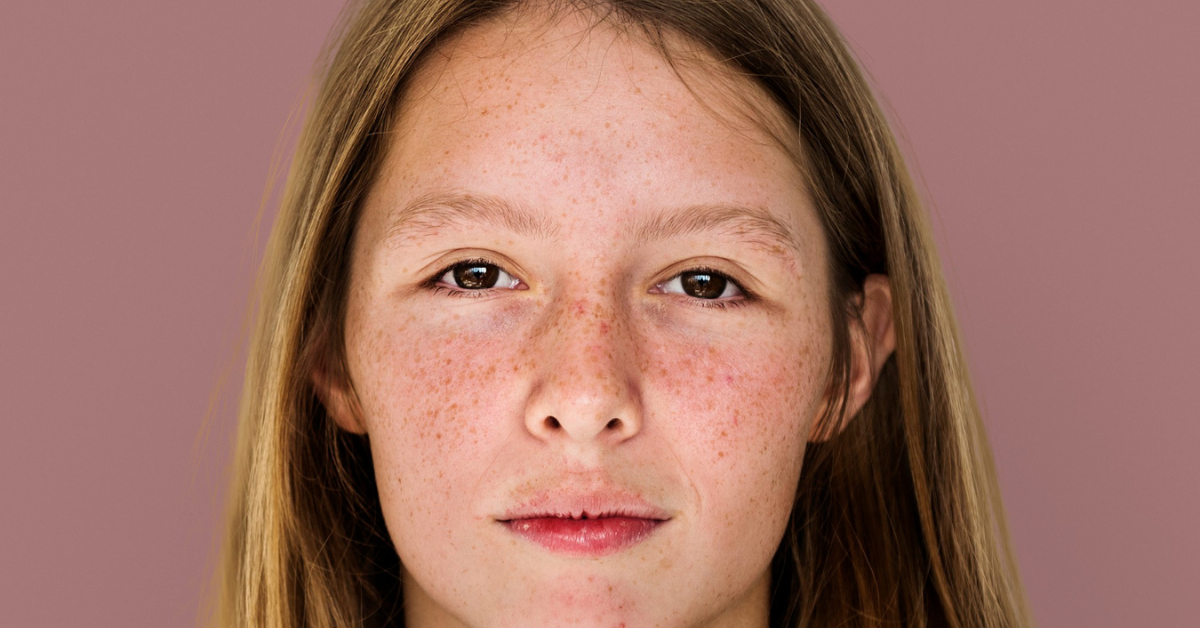Hello everyone and welcome to Ketsha! In this particular blog, we are talking about one very common yet very unwelcome skin problem that almost every person in the world would have to face, and I’m talking about freckles.
Freckles are small, flat, light brown or tan spots that appear on the skin, and most of the time they happen in areas where the exposure to sunlight is greater.
What is Freckles
Freckles are one type of pigmentation that is usually harmless and is common because every individual with fair and bright skin can easily have this problem. If you want to know why this skin problem arise, then the simple reason is the excessive production of melanin.
Sometimes freckles can be genetic and can result from sun exposure. The freckles themselves are not harmful, but they are an indication that your skin is damaged by the sun.
So, I hope you now know what freckles are, but now we need to know why they happen and how to cure them. It’s also quite important to know how we can protect our skin from freckles.
Without any further delay, let’s get into the blog.
Types of Freckles
There are three primary types of freckles:
-
Ephelides Freckles
These are the common, light brown spots that appear on sun-exposed areas, especially in fair-skinned individuals. They tend to darken during sun exposure and lighten in the winter.
-
Lentigines Freckles
Also known as “liver spots” or “age spots,” lentigines are larger, darker spots that are not always related to sun exposure. They can appear on people of all skin types, often as a result of aging.
-
Solar Lentigines
These are similar to lentigines but are specifically caused by sun exposure. They’re more common in older adults and are usually larger and darker than ephelides.
What Causes Freckles
Let’s dive into the main reasons for freckles as there are many different factors that might result in freckles on the skin.
- Genetics: Freckles can arise due to various factors, with genetics playing a significant role. If your parents have freckles, there’s a higher likelihood that you might also develop them.
- Sun Exposure: Sun exposure, particularly to UV radiation, is another key factor in freckle formation. UV radiation prompts the skin to produce melanin, the pigment responsible for skin, hair, and eye color. Individuals with fair skin often have more freckles since they possess lower initial melanin levels. However, when exposed to sunlight, their skin produces more melanin as a defense against sun damage, resulting in the appearance of freckles.
- Skin Type: Skin type is crucial in freckle development. Those with fair or light skin have limited melanin, making them susceptible to sun-induced damage and freckle formation. Conversely, people with darker skin have higher melanin levels, offering better natural protection.
- Hormonal Changes: Hormonal changes, such as those occurring during puberty, pregnancy, or hormonal therapies, can also trigger freckles. These changes can lead to increased melanin production, contributing to freckle development.
It’s important to remember that freckles can be natural or require specific skin care. Regardless of the cause, if you’re dealing with freckles, there’s no need to worry or feel disheartened. Many individuals experience this phenomenon, and it’s essential to embrace your beauty and uniqueness.
How to Manage Freckles
Most people who have freckles frequently ask, How to stop getting freckles? Can freckles disappear after doing proper skin care? The answer is no. Freckles cannot disappear at all. Of course, you can lighten your freckles, but they will not disappear totally.
Then what should we do? The answer is to practice proper skin care. and in this section, we will talk about how you can manage your freckles and make them light and what steps and routines you need to follow to make it happen.
So let’s know what we need to do.
Sun Protection
Sun exposure is a primary contributor to the development and darkening of freckles. To protect your skin from harmful UV radiation, follow these guidelines:
- Sunscreen: Apply a broad-spectrum sunscreen with a high SPF (30 or higher) daily, even on cloudy days. Reapply every two hours, and more frequently if sweating or swimming.
- Protective Clothing: Wear long-sleeved shirts, pants, wide-brimmed hats, and sunglasses with UV protection to shield your skin and eyes from the sun’s rays.
- Seek Shade: When the sun is at its strongest, usually between 10 a.m. and 4 p.m., try to stay in the shade to reduce sun exposure.
Skin Care
Incorporate certain skincare practices and products to help manage freckles.
- Antioxidants: Use skincare products containing antioxidants like vitamin C, vitamin E, and green tea extract. These can help protect your skin from oxidative stress and lighten existing freckles.
- Vitamin C: Products with vitamin C can help brighten skin and fade pigmentation over time.
- Niacinamide: Niacinamide is known to regulate melanin production, which can assist in preventing and lightening freckles.
Topical Treatments
Consult a dermatologist for guidance on topical treatments tailored to your skin’s needs.
- Hydroquinone: Available both over-the-counter and by prescription, hydroquinone can lighten freckles and other hyperpigmentation by inhibiting melanin production.
- Retinoids: Prescription retinoids like tretinoin can accelerate skin cell turnover, fading freckles gradually.
- Glycolic Acid: Over-the-counter or prescription glycolic acid products can exfoliate the skin’s top layer, reducing the appearance of freckles.
Chemical Peels
Dermatologists can perform chemical peels to address freckles.
- Procedure: A chemical solution is applied to the skin, causing it to exfoliate and eventually peel off. This reveals fresher, less pigmented skin underneath.
- Professional Care: Chemical peels should be done by a trained dermatologist to avoid complications.
Laser Therapy
Laser treatments can target freckles more directly.
- Intense Pulsed Light (IPL) Therapy: IPL emits light energy that targets melanin and breaks down pigmentation, leading to a reduction in freckles’ visibility.
- Fractional Laser: This laser targets specific areas of the skin, promoting collagen production and reducing pigmentation.
Hormonal Triggers
If hormonal changes contribute to your freckles, consider these strategies:
- Balanced Lifestyle: Maintain a balanced diet, exercise regularly, and manage stress to help stabilise hormonal fluctuations.
- Proper Skincare: Continue using sunscreen and skincare products with antioxidants to prevent further pigmentation.
Cosmetic Camouflage:
For temporary coverage of freckles:
- Makeup: Use makeup products like foundation and concealer to cover freckles when desired.
Healthy Diet and Hydration:
A balanced diet and hydration contribute to overall skin health.
- Antioxidant-Rich Foods: Consume foods rich in antioxidants, such as berries, citrus fruits, and leafy greens, to support skin health.
- Hydration: Drink plenty of water and use moisturizers to maintain hydrated, healthy-looking skin.
Professional Consultation:
For personalized advice and significant freckle reduction:
- Dermatologist Visit: Consult a dermatologist to determine the most suitable treatment options for your skin type, freckle severity, and goals.
Skincare Routine for Freckles
Having the right skincare routine is super important to manage your freckles. With the best routine, you can make your freckles lighter really fast. So, here’s a great skincare plan for you to follow:
- Cleanser: Start your day with a gentle cleanser to remove impurities and prepare your skin for the following steps.
- Antioxidant Serum: Apply a serum containing antioxidants like vitamin C. Antioxidants help protect your skin from damage caused by UV rays and environmental factors.
- Sunscreen: Apply a broad-spectrum sunscreen with SPF 30 or higher. This step is crucial to preventing further darkening of freckles due to sun exposure.
- Makeup (optional): If you use makeup, consider using a foundation or concealer with SPF for additional sun protection.
Daytime Maintenance:
- Sun Protection: Reapply sunscreen every two hours if you’re outdoors. If you sweat or swim, reapply more frequently.
Evening Routine:
- Makeup Removal and Cleansing: Use a makeup remover followed by a gentle cleanser to thoroughly cleanse your skin and remove any makeup, sunscreen, or impurities.
- Exfoliation (1-3 times a week): Depending on your skin’s sensitivity, use a mild exfoliator like a chemical exfoliant with glycolic acid or a gentle scrub. Exfoliation helps remove dead skin cells and can aid in fading freckles over time.
- Treatment Serum: Apply a serum containing niacinamide, which can help regulate melanin production and fade pigmentation. You can also include other targeted treatments recommended by your dermatologist, such as hydroquinone or retinoids, if applicable.
- Moisturiser: Choose a moisturiser suitable for your skin type to keep your skin hydrated and maintain its barrier function.
Weekly Treatments:
- Face Mask (1-2 times a week): Consider using a brightening or clarifying face mask with ingredients like vitamin C, kojic acid, or licorice extract to promote an even skin tone.
Additional Tips:
- Hydration: Drink plenty of water throughout the day to keep your skin hydrated from within.
- Diet: Consume a diet rich in fruits, vegetables, and whole foods, which provide essential vitamins and antioxidants for skin health.
- Avoid Irritants: Be cautious with harsh products, as they can irritate the skin and worsen pigmentation. Always do a patch test before trying new products.
- Consistency: Skincare takes time to show results. Consistently follow your routine and be patient with the process.
- Professional Consultation: Consult a dermatologist before adding potent treatments like hydroquinone or retinoids, especially if you have sensitive skin or other skin concerns.
So, here we have completed our freckles topic. I have shared all the details and explained everything in a very easy way. I hope you find it helpful. So stay tuned for the next important topic about skincare and hair care. Bye Bye!
Disclaimer: Content provided on this blog is for informational purposes only. This blog is not intended to provide diagnosis, treatment or medical advice. Information on this blog channel should not be considered as a substitute for advice from a healthcare professional. Please consult with a physician or other healthcare professional regarding any medical or health related diagnosis or treatment options.




